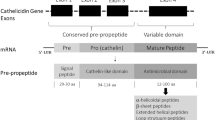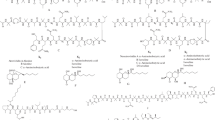Abstract
Although glycine-rich antimicrobial peptides (AMPs) are found in animals and plants, very little has been reported on their chemistry, structure activity-relationship, and properties. We investigated those topics for Shepherin I (Shep I), a glycine-rich AMP with the unique amino acid sequence G1YGGHGGHGGHGGHGGHGGHGHGGGGHG28. Shep I and analogues were synthesized by the solid-phase method at 60 °C using conventional heating. Purification followed by chemical characterization confirmed the products' identities and high purity. Amino acid analysis provided their peptide contents. All peptides were active against the clinically important Candida species, but ineffective against bacteria and mycelia fungi. Truncation of the N- or C-terminal portion reduced Shep I antifungal activity, the latter being more pronounced. Carboxyamidation of Shep I did not affect the activity against C. albicans or C. tropicalis, but increased activity against S. cerevisiae. Carboxyamidated analogues Shep I (3-28)a and Shep I (6-28)a were equipotent to Shep I and Shep Ia against Candida species. As with most cationic AMPs, all peptides had their activity significantly reduced in high-salt concentrations, a disadvantage that is defeated if 10 µM ZnCl2 is present. At 100 µM, the peptides were practically not hemolytic. Shep Ia also killed C. albicans MDM8 and ATCC 90028 cells. Fluo-Shep Ia, an analogue labeled with 5(6)-carboxyfluorescein, was rapidly internalized by C. albicans MDM8 cells, a salt-sensitive process dependent on metabolic energy and temperature. Altogether, such results shed light on the chemistry, structural requirements for activity, and other properties of candidacidal glycine-rich peptides. Furthermore, they show that Shep Ia may have strong potential for use in topical application.





Similar content being viewed by others
Abbreviations
- Shep I :
-
Shepherin I
- SAR:
-
Structure–activity relationship
- AMPs:
-
Antimicrobial peptides
- MIC:
-
Minimal inhibitory concentration
- Fluo :
-
5(6)-Carboxyfluorescein
- GRP:
-
Glycine-rich peptide or protein
- Boc:
-
Tert-butyloxycarbonyl
- Fmoc:
-
9-Fluorenylmethyloxycarbonyl
- Tos:
-
Tosyl
- PAM:
-
4-Hydroxymethyl-phenylacetamidomethyl
- NMP:
-
N-methyl-2-pyrrolidone
- DMSO:
-
Dimethyl sulfoxide
- PBS:
-
Phosphate-buffered saline
- IGP:
-
Isotonic glucose phosphate
- PBC:
-
Phosphate-borate-citrate
- TFE:
-
2,2,2-Trifluoroethanol
- SDS:
-
Sodium dodecyl sulfate
- PDB:
-
Potato dextrose broth
References
Altschul SF, Madden TL, Schäffer AA, Zhang J, Zhang Z, Miller W, Lipman DJ (1997) Gapped BLAST and PSI-BLAST: a new generation of protein database search programs. Nucleic Acids Res 25:3389–3402
Baumann T, Kämpfer U, Schürch S, Schaller J, Largiadèr C, Nentwig W, Kuhn-Nentwig L (2010) Ctenidins: antimicrobial glycine-rich peptides from the hemocytes of the spider Cupiennius salei. Cell Mol Life Sci 67:2787–2798
Bechinger B (2013) Nanosized vectors for transfection assembled from peptides and nucleic acids. In: Aleman C, Bianco A, Venanzi M (eds) Peptide materials: from nanostructures to applications. J Wiley, West Sussex, pp 247–264
Bulet P, Hetru C, Dimarcq JL, Hoffmann D (1999) Antimicrobial peptides in insects; structure and function. Dev Comp Immunol 23:329–344
Chen AP, Zhong NQ, Qu ZL, Wang F, Liu N, Xia GX (2007) Root and vascular tissue-specific expression of glycine-rich protein AtGRP9 and its interaction with AtCAD5, a cinnamyl alcohol dehydrogenase, in Arabidopsis thaliana. J Plant Res 120:337–343
Clinical and Laboratory Standards Institute (2008) Reference method for broth dilution antifungal susceptibility testing of yeasts; Approved standard—3rd edition. CLSI document M27-A3. CLSI, Wayne
Colombo AL, Janini M, Salomao R, Medeiros EAS, Wey SB, Pignatari ACC (2009) Surveillance programs for detection and characterization of emergent pathogens and antimicrobial resistance. Results from the division of infectious diseases. UNIFESP An Acad Bras Cienc 81:571–587
De Souza Cândido E, Pinto MFS, Pelegrini PB, Lima TB, Silva ON, Pogue R, Grossi-de-Sá MF, Franco OL (2011) Plant storage proteins with antimicrobial activity: novel insights into plant defense mechanisms. FASEB J 25:3290–3305
Edgar RC (2004) MUSCLE: multiple sequence alignment with high accuracy and high throughput. Nucleic Acids Res 32:1792–1797
Ehret-Sabatier L, Loew D, Goyffon M, Fehlbaum P, Hoffmann JA, van Dorsselaer A, Bulet P (1996) Characterization of novel cysteine-rich antimicrobial peptides from scorpion blood. J Biol Chem 271:29537–29544
Eschenauer GA, Nguyen MH, Shoham S, Vazquez JA, Morris AJ, Pasculle WA, Kubin CJ, Klinker KP, Carver PL, Hanson KE, Chen S, Lam SW, Potoski BA, Clarke LG, Shields RK, Clancy CJ (2014) Real-World experience with echinocandin MICs against Candida species in a multicenter study of hospitals that routinely perform susceptibility testing of bloodstream isolates. Antimicrob Agents Chemother 58:1897–1906
Falcomer CM, Meinwald YC, Choudhary I, Talluri S, Milburn PJ, Clardy J, Scheraga HA (1992) Chain reversals in model peptides: studies of cystine-containing cyclic peptides. 3. Conformational free energies of cyclization of tetrapeptides of sequence Ac-Cys-Pro-X-Cys-NHMe. J Am Chem Soc 114:4036–4042
Fehlbaum P, Bulet P, Michaut L, Lagueux M, Broekaert WF, Hetru C, Hoffmann JA (1994) Insect immunity. Septic injury of Drosophila induces the synthesis of a potent antifungal peptide with sequence homology to plant antifungal peptides. J Biol Chem 269:33159–33163
Finn RD, Tate J, Mistry J, Coggill PC, Sammut SJ, Hotz HR, Ceric G, Forslund K, Eddy SR, Sonnhammer ELL, Bateman A (2008) The Pfam protein families database. Nucleic Acids Res 36:D281–D288
Fitzgerald DH, Coleman DC, O’Connell BC (2003) Susceptibility of Candida dubliniensis to salivary histatin 3. Antimicrob Agents Chemother 47:70–76
Franco OL (2011) Peptide promiscuity: an evolutionary concept for plant defense. FEBS Lett 585:995–1000
Fruchart-Gaillard C, Mourier G, Blanchet G, Vera L, Gilles N, Ménez R, Marcon E, Stura EA, Servent D (2012) Engineering of three-finger fold toxins creates ligands with original pharmacological profiles for muscarinic and adrenergic receptors. PLoS ONE 7:e39166
Geourjon C, Deleage G (1995) SOPMA: significant improvements in protein secondary structure prediction by consensus prediction from multiple alignments. Comput Appl Biosci 11:681–684
Hancock REW, Sahl HG (2006) Antimicrobial and host-defense peptides as new anti-infective therapeutic strategies. Nat Biotech 24:1551–1557
Helmerhorst EJ, Reijnders IM, van ‘t Hof W, Veerman ECI, Nieuw Amerongen AV (1999a) A critical comparison of the hemolytic and fungicidal activities of cationic antimicrobial peptides. FEBS Lett 449:105–110
Helmerhorst EJ, Breeuwer P, van’t Hof W, Walgreen-Weterings E, Oomen LC, Veerman EC, Amerongen AV, Abee T (1999b) The cellular target of histatin 5 on Candida albicans is the energized mitochondrion. J Biol Chem 27:7286–7291
Herbinière J, Braquart-Varnier C, Grève P, Strub J-M, Frère J, Van Dorsselaer A, Martin G (2005) Armadillidin: a novel glycine-rich antibacterial peptide directed against gram-positive bacteria in the woodlouse Armadillidium vulgare (Terrestrial Isopod, Crustacean). Dev Comp Immunol 29:489–499
Hoffman HL, Pfaller MA (2001) In vitro antifungal susceptibility testing. Pharmacotherapy 21:111S–123S
Hoffmann-Santos H, Paula C, Yamamoto A, Tadano T, Hahn R (2013) Six-year trend analysis of nosocomial Candidemia and risk factors in two intensive care hospitals in Mato Grosso, Midwest region of Brazil. Mycopathologia 176:409–415
Iijima R, Kurata S, Natori S (1993) Purification, characterization, and cDNA cloning of an antifungal protein from the hemolymph of Sarcophaga peregrina (flesh fly) larvae. J Biol Chem 268:12055–12061
Jang WS, Bajwa JS, Sun JN, Edgerton M (2010) Salivary histatin 5 internalization by translocation, but not endocytosis, is required for fungicidal activity in Candida albicans. Mol Microbiol 77:354–370
Kim DH, Lee DG, Kim KL, Lee Y (2001) Internalization of tenecin 3 by a fungal cellular process is essential for its fungicidal effect on Candida albicans. Eur J Biochem 268:4449–4458
Kim JY, Park SC, Yoon MY, Hahm KS, Park Y (2011) C-terminal amidation of PMAP-23: translocation to the inner membrane of Gram-negative bacteria. Amino Acids 40:183–195
Kumar Sinha A, Norouzitallab P, Baruah K (2009) Antimicrobial peptides: possible therapeutics in aquaculture. World Aquacult 40:50–53
Kumar R, Chadha S, Saraswat D, Bajwa JS, Li RA, Conti HR, Edgerton M (2011) Histatin 5 uptake by Candida albicans utilizes polyamine transporters Dur3 and Dur31 proteins. J Biol Chem 286:43748–43758
Lee S, Moon H, Kurata S, Natori S, Lee B (1995) Purification and cDNA cloning of an antifungal protein from the hemolymph of Holotrichia diomphalia larvae. Biol Pharm Bull 18:1049–1052
Loffredo C, Assunção NA, Gerhardt J, Miranda MTM (2009) Microwave-assisted solid-phase peptide synthesis at 60 °C: alternative conditions with low enantiomerization. J Pept Sci 15:808–817
Lorenzini DM, Da Silva PI, Fogaca AC, Bulet P, Daffre S (2003) Acanthoscurrin: a novel glycine-rich antimicrobial peptide constitutively expressed in the hemocytes of the spider Acanthoscurria gomesiana. Dev Comp Immunol 27:781–791
Machado A, Sforça ML, Miranda M, Daffre S, Pertinhez TA, Spisni A, MTM M (2007) Truncation of amidated fragment 33-61 of bovine α-hemoglobin: effects on the structure and anticandidal activity. Biopolymers 88:413–426
Matejuk A, Leng Q, Begum MD, Woodle MC, Scaria P, Chou ST, Mixson AJ (2010) Peptide-based antifungal therapies against emerging infections. Drug Future 35:197–217
Nakagawa O, Ming X, Carver K, Juliano R (2013) Conjugation with receptor-targeted histidine-rich peptides enhances the pharmacological effectiveness of antisense oligonucleotides. Bioconjug Chem 25:165–170
Oppenheim FG, Helmerhorst EJ, Lendenmann U, Offner GD (2012) Anti-Candidal activity of genetically engineered histatin variants with multiple functional domains. PLoS ONE 7:e51479
Park CJ, Park CB, Hong SS, Lee HS, Lee SY, Kim SC (2000) Characterization and cDNA cloning of two glycine- and histidine-rich antimicrobial peptides from the roots of shepherd’s purse, Capsella bursa-pastoris. Plant Mol Biol 44:187–197
Pelegrini PB, Murad AM, Silva LP, Dos Santos RCP, Costa FT, Tagliari PD, Bloch C Jr, Noronha EF, Miller RNG, Franco OL (2008) Identification of a novel storage glycine-rich peptide from guava (Psidium guajava) seeds with activity against Gram-negative bacteria. Peptides 29:1271–1279
Plum LM, Rink L, Haase H (2010) The essential toxin: impact of zinc on human health. Int J Environ Res Public Health 7:1342–1365
Rao AG (1999) Conformation and antimicrobial activity of linear derivatives of tachyplesin lacking disulfide bonds. Arch Biochem Biophys 361:127–134
Remuzgo C, Andrade GFS, Temperini MLA, Miranda MTM (2009) Acanthoscurrin fragment 101–132: total synthesis at 60 °C of a novel difficult sequence. Biopolymers 92:65–75
Ringli C, Keller B, Ryser U (2001) Glycine-rich proteins as structural components of plant cell walls. Cell Mol Life Sci 58:1430–1441
Rydengard VN, Andersson Nordahl E, Schmidtchen A (2006) Zinc potentiates the antibacterial effects of histidine-rich peptides against Enterococcus faecalis. FEBS J 273(11):2399–2406
Sachetto-Martins GF, Franco LO, De Oliveira DE (2000) Plant glycine-rich proteins: a family or just proteins with a common motif? Biochim Biophys Acta 1492:1–14
Slotte T, Ceplitis A, Neuffer B, Hurka H, Lascoux M (2006) Intrageneric phylogeny of Capsella (Brassicaceae) and the origin of the tetraploid C. bursa-pastoris based on chloroplast and nuclear DNA sequences. Am J Bot 93:1714–1724
Sousa JC, Berto RF, Gois EA, Fontenele-Cardi NC, Honório-Júnior JER, Konno K, Richardson M, Rocha MFG, Camargo AACM, Pimenta DC, Cardi BA, Carvalho KM (2009) Leptoglycin: a new Glycine/Leucine-rich antimicrobial peptide isolated from the skin secretion of the South American frog Leptodactylus pentadactylus (Leptodactylidae). Toxicon 54:23–32
Souza MP, Tavares MFM, Miranda MTM (2004) Racemization in stepwise solid-phase peptide synthesis at elevated temperatures. Tetrahedron 60:4671–4681
Sperstad SV, Haug T, Vasskog T, Stensvåg K (2009) Hyastatin, a glycine-rich multi-domain antimicrobial peptide isolated from the spider crab (Hyas araneus) hemocytes. Mol Immunol 46:2604–2612
Szeto HH, Schiller PW, Zhao K, Luo G (2005) Fluorescent dyes alter intracellular targeting and function of cell-penetrating tetrapeptides. FASEB J 19:118–120
Varanda LM, Miranda MT (1997) Solid-phase peptide synthesis at elevated temperatures: a search for and optimized synthesis condition of unsulfated cholecystokinin-12. J Pept Res 50:102–108
Yang JT, Wu CS, Martinez HM (1986) Calculation of protein conformation from circular dichroism. In: Hirs CHW, Timasheff SN (eds) Enzyme structure part k methods in enzymology. Academic Press, New York, pp 208–269
Acknowledgments
This work was supported by FAPESP (grants 04/14376-7 and 08/11695-1 to MTM) and CNPq (142022/2003-9, a doctoral fellowship for CR). We thank Dr. Nilton Lincopan (for providing C. albicans ATCC 90028 and HU 168 strains), Dr. Cleber W. Liria (for amino acid analyses), Adriana Y. Matzukuma and Roberto C. Modia (for assistance with FACS and confocal microscopy, respectively), and Gustavo P.B. Carretero (for theoretical structure prediction).
Conflict of interest
The authors declare that they have no conflicts of interest.
Author information
Authors and Affiliations
Corresponding author
Electronic supplementary material
Below is the link to the electronic supplementary material.
Rights and permissions
About this article
Cite this article
Remuzgo, C., Oewel, T.S., Daffre, S. et al. Chemical synthesis, structure–activity relationship, and properties of shepherin I: a fungicidal peptide enriched in glycine-glycine-histidine motifs. Amino Acids 46, 2573–2586 (2014). https://doi.org/10.1007/s00726-014-1811-2
Received:
Accepted:
Published:
Issue Date:
DOI: https://doi.org/10.1007/s00726-014-1811-2




